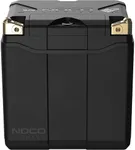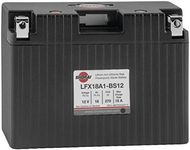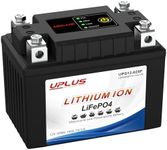Buying Guide for the Best Lithium Motorcycle Batteries
Choosing the right lithium motorcycle battery is important for ensuring reliable starts, long battery life, and safe operation of your motorcycle. Lithium batteries are popular because they are lighter, have a longer lifespan, and require less maintenance compared to traditional lead-acid batteries. However, not all lithium batteries are the same, and picking the right one depends on understanding a few key specifications and matching them to your motorcycle’s needs and your riding habits.Battery Capacity (Ah)Battery capacity, measured in ampere-hours (Ah), tells you how much energy the battery can store and deliver over time. A higher Ah rating means the battery can power your motorcycle’s electrical systems for longer before needing a recharge. Small motorcycles or scooters may need a lower capacity, while larger bikes with more electronics or higher compression engines require a higher capacity. To choose the right capacity, check your motorcycle’s manual for the recommended value and consider your riding style—if you use a lot of accessories or ride long distances, a higher capacity may be beneficial.
Cold Cranking Amps (CCA)Cold Cranking Amps (CCA) is a measure of how much current the battery can deliver at low temperatures, which is important for starting your motorcycle in cold weather. A higher CCA means the battery can provide more power to start the engine when it’s cold. If you live in a colder climate or your bike is hard to start, look for a battery with a higher CCA. For warm climates or easy-starting bikes, a lower CCA may be sufficient.
Physical Size and Terminal OrientationThe physical size and terminal orientation refer to the battery’s dimensions and the position of its positive and negative terminals. It’s important because the battery must fit securely in your motorcycle’s battery compartment and the terminals must align with your bike’s wiring. Batteries come in various sizes and terminal layouts, so always check your motorcycle’s requirements and compare them to the battery’s specifications to ensure a proper fit.
WeightLithium batteries are much lighter than traditional batteries, which can improve your motorcycle’s handling and performance. The weight of the battery is especially important for sport or racing motorcycles where every kilogram counts. If you’re looking to reduce your bike’s overall weight, pay attention to this spec. For casual riders, weight may be less critical, but it’s still a nice benefit.
Built-in Battery Management System (BMS)A Battery Management System (BMS) is an internal circuit that protects the battery from overcharging, deep discharging, and overheating. This is important for safety and for extending the battery’s lifespan. Some lithium batteries come with a built-in BMS, while others do not. If you want a worry-free experience and maximum safety, look for a battery with a BMS, especially if your motorcycle’s charging system is not specifically designed for lithium batteries.
Charging RequirementsLithium batteries often have different charging requirements compared to lead-acid batteries. Some need special chargers or have limits on charging voltage. It’s important to check what type of charger is recommended and whether your motorcycle’s charging system is compatible. If you plan to use your existing charger, make sure it’s safe for lithium batteries. Picking a battery that matches your charging setup will help avoid damage and ensure reliable performance.

















